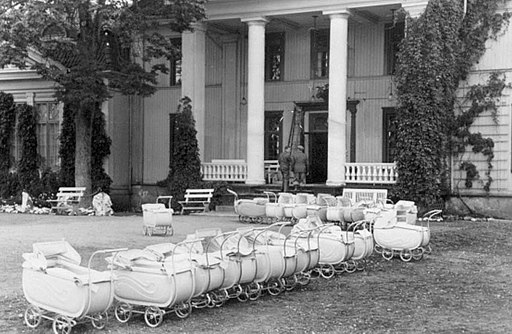Summary | Excerpt | Reading Guide | Discuss | Reviews | Beyond the Book | Read-Alikes | Genres & Themes | Author Bio

A Novel
by Jennifer CoburnThis article relates to Cradles of the Reich
 Jennifer Coburn's novel Cradles of the Reich largely takes place in Germany's first Lebensborn ("Fount of Life") home, Heim Hochland. Germany's economic hardship following its defeat in World War I was a key factor in the National Socialist Party (aka the Nazi Party) gaining control of the country in 1933. Led by Adolf Hitler, the Nazi Party had as one of its chief aims creating a country of genetically superior citizens. They determined that one of the barriers to their goal was Germany's declining birthrate; 1915–1933 saw 14 million fewer births than 1896–1914. The Nazis initially enacted policies in the hopes of turning the tide; for example, women with large families were publicly rewarded, abortions were strictly limited and women's occupational and educational opportunities were severely curtailed. These measures, however extreme, nevertheless had little impact on the birth rate.
Jennifer Coburn's novel Cradles of the Reich largely takes place in Germany's first Lebensborn ("Fount of Life") home, Heim Hochland. Germany's economic hardship following its defeat in World War I was a key factor in the National Socialist Party (aka the Nazi Party) gaining control of the country in 1933. Led by Adolf Hitler, the Nazi Party had as one of its chief aims creating a country of genetically superior citizens. They determined that one of the barriers to their goal was Germany's declining birthrate; 1915–1933 saw 14 million fewer births than 1896–1914. The Nazis initially enacted policies in the hopes of turning the tide; for example, women with large families were publicly rewarded, abortions were strictly limited and women's occupational and educational opportunities were severely curtailed. These measures, however extreme, nevertheless had little impact on the birth rate.
Reichsführer-SS Heinrich Himmler came up with the idea of creating a program to encourage "genetically pure" women to have more children, and as a result Heim Hochland opened near Munich in 1936, followed by nine other facilities in Germany over the ensuing years. The homes served as maternity hospitals, where pregnant women who met the Aryan ideal were pampered to ensure healthy offspring. Married women's husbands could claim custody of their infants after birth, but the children of unmarried women were given to the wives of high-ranking German officers to adopt. The centers also housed young, unmarried women from the League of German Girls, who were encouraged to have sex with visiting German officials for the good of the Reich. Around 8,000 Lebensborn children were sired in Germany alone.
The homes also served as adoption agencies for blond, blue-eyed children stolen from their parents in conquered territories such as Poland. Up to 200,000 Polish children were abducted; these children were given physical and psychological exams, and those who passed were put up for adoption. Those who didn't were either sent to Auschwitz or euthanized locally. Children aged two to six were given to childless SS families, while older ones were placed in state schools. The children were told that their parents were dead and had been "shameful" (e.g., prostitutes, alcoholics) and that they should be grateful they'd been "rescued." They were given German names, forbidden to speak their native languages and received harsh discipline to warp them into obedient servants of the Reich. Those who were uncooperative or later showed un-Aryan traits were sent to Auschwitz.
As the Nazis occupied more countries, they set up Lebensborn homes in territories they felt could produce the type of infant they prized. The program ultimately expanded to the eight countries within Germany's sphere of influence: Germany, Austria, Poland, Norway, France, Belgium, the Netherlands and Luxembourg. The Nazis were particularly interested in Norwegian children, since they felt that country's population was genetically similar to Germany's, and in 1941 the first Lebensborn home outside of Germany opened in Norway. By the war's conclusion the nation had nine of these facilities, more than any country besides Germany, and had produced between 6,000 and 12,000 children.
Many Norwegian Lebensborn children, known as Tyskerbarnas ("German children") suffered after the war. Thousands were returned to Norway but didn't know their real names and no longer spoke Norwegian. The government, who considered them to be "dangerous" due to their German blood, tried unsuccessfully to deport them back to Germany as well as Austria and Brazil. For the most part, though, the children who no longer had an adult guardian were placed in psychiatric hospitals, where they remained for years, often neglected or abused. In 2001, a group of these individuals tried to sue the Norwegian government over their lost childhoods, but their claim was denied due to too much time having elapsed. As part of a larger settlement a year later, however, they were offered compensation of about $31,000, along with a formal apology.
Native Norwegians detested the women who participated in the program, referring to them as "horizontal collaborators." After the war, these "German girls" were denied jobs, shunned, physically attacked and deported. Many fled the country to escape maltreatment, but 14,000 were arrested on "suspicion of collaboration" and sentenced to 18 months of hard labor. The Norwegian government eventually apologized to the estimated 50,000 women who participated in the program, but not until 2018, when few of the affected women were still alive.
Photo from Lebensborn birth house in Nazi-occupied Norway during WWII, courtesy of Riksarkivet (National Archives of Norway) via Wikimedia Commons
Filed under Society and Politics
![]() This "beyond the book article" relates to Cradles of the Reich. It originally ran in November 2022 and has been updated for the
July 2023 paperback edition.
Go to magazine.
This "beyond the book article" relates to Cradles of the Reich. It originally ran in November 2022 and has been updated for the
July 2023 paperback edition.
Go to magazine.
Your guide toexceptional books
BookBrowse seeks out and recommends the best in contemporary fiction and nonfiction—books that not only engage and entertain but also deepen our understanding of ourselves and the world around us.